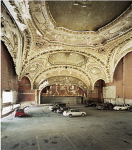Detroit is the butt of jokes by many people, including (especially?) people who have never visited the city. “That’s so Detroit.”
These jokes, in one way or another, of course refer to Detroit’s rapid decline over the past several decades. Economies tend to evolve in the following order: natural resource/agricultural based economy, transition to manufacturing based economy, and finally transition to a service/ideas based economy. Unfortunately for Detroit, it is a manufacturing city in one of the wealthiest nations in the world. The rise of the service and idea based economy has coincided with the decline of the automotive industry and manufacturing in general. Detroit has gone down with it. Unlike some other manufacturing cities, for a host of reasons it has utterly failed to transition into providing some other service to the global economy.
In the past couple years the city and its plight have popped up in discussions and things I have read and watched. I really enjoyed Gran Torino and its treatment of Detroit’s changing social fabric as a result of the manufacturing decline. That it wasn’t nominated for Best Picture given its competition was bizarre. Frost-Nixon was nominated? Really?
I also enjoyed David Byrne’s post about his experiences in the motor city, including his bike tour. He gives what I believe to be a fair interpretation of the forces that have shaped Detroit in the past fifty years, even if he views it as more of a centralized process (i.e. “man-made”) while I believe it to be more decentralized (i.e. economic development). The pictures alone warrant giving it a glance. Below is the Michigan theater, in it’s glory and now … as a parking lot (Click to enlarge. Note the marquee: “Acre of Seats.”)



A month ago one of my classmates told a couple wild stories about the city. One was that there were no grocery stores within a half hour drive of downtown Detroit. A more absurd story was about people making money shooting raccoons. When I later read Byrne’s story, including the bit about pheasants in city limits, I re-classified the raccoon story as “less absurd.” When I read the scariest sentences Ezra Klein read yesterday, namely that there isn’t a chain grocery store in city limits, I was even more inclined to believe it.
None of these things have positively changed my opinion regarding Detroit as a fun, beautiful, or uplifting city. In fact just the opposite. If possible, I now think of it as even more dirty and dangerous than I did before.
But something has changed. The social scientist in me has (perhaps fittingly) joined forces with the small part of everyone who wants to long-neck it when passing a car-crash: I want to see what a deserted major city looks like. Where before I only thought of the superficial drawbacks of Detroit (e.g. high murder and other crime rates, abandoned buildings, etc), I now view the city as a case study in creative destruction. The same forces that have made so many people in other parts of the world (and in this country) so much better off have caused the abandonment of a former industrial center. It’s the side of the economy and global community that some people focus on exclusively and others neglect completely. But what does it look like? How does it feel to stand in grand, empty, and utterly neglected man-made spaces?
I think this summer I will drive the 8 or 9 hours from DC to Detroit and find out, perhaps with some fly fishing and camping thrown in if I have time.






